
A code talker was a person employed by the military during wartime to use a little-known language as a means of secret communication. The term is most often used for United States service members during the World Wars who used their knowledge of Native American languages as a basis to transmit coded messages. In particular, there were approximately 400 to 500 Native Americans in the United States Marine Corps whose primary job was to transmit secret tactical messages. Code talkers transmitted messages over military telephone or radio communications nets using formally or informally developed codes built upon their Indigenous languages. The code talkers improved the speed of encryption and decryption of communications in front line operations during World War II and are credited with some decisive victories. Their code was never broken.

San Juan County is a county in the southeastern portion of the U.S. state of Utah. As of the 2020 United States Census, the population was 14,518. Its county seat is Monticello, while its most populous city is Blanding. The Utah State Legislature named the county for the San Juan River, itself named by Spanish explorers.

Window Rock, known in Navajo as Tségháhoodzání, is a city and census-designated place that serves as the capital of the Navajo Nation, the largest Native American tribe by both land and tribal enrollment. The capital lies within the boundaries of the St. Michaels Chapter, adjacent to the Arizona and New Mexico state line. Window Rock is the site of the Navajo Nation governmental campus, which contains the Navajo Nation Council, Navajo Nation Supreme Court, the offices of the Navajo Nation President and Vice President, and many Navajo government buildings.

The Navajo Nation, also known as Navajoland, is an Indian reservation of Navajo people in the United States. It occupies portions of northeastern Arizona, northwestern New Mexico, and southeastern Utah. The seat of government is located in Window Rock, Arizona.

Navajo or Navaho is a Southern Athabaskan language of the Na-Dené family, as are other languages spoken across the western areas of North America. Navajo is spoken primarily in the Southwestern United States, especially in the Navajo Nation. It is one of the most widely spoken Native American languages and is the most widely spoken north of the Mexico–United States border, with almost 170,000 Americans speaking Navajo at home as of 2011.

The San Juan River is a major tributary of the Colorado River in the Southwestern United States, providing the chief drainage for the Four Corners region of Colorado, New Mexico, Utah, and Arizona. Originating as snowmelt in the San Juan Mountains of Colorado, it flows 383 miles (616 km) through the deserts of northern New Mexico and southeastern Utah to join the Colorado River at Glen Canyon.

Canyon de Chelly National Monument was established on April 1, 1931, as a unit of the National Park Service. Located in northeastern Arizona, it is within the boundaries of the Navajo Nation and lies in the Four Corners region. Reflecting one of the longest continuously inhabited landscapes of North America, it preserves ruins of the indigenous tribes that lived in the area, from the Ancestral Puebloans to the Navajo. The monument covers 83,840 acres and encompasses the floors and rims of the three major canyons: de Chelly, del Muerto, and Monument. These canyons were cut by streams with headwaters in the Chuska Mountains just to the east of the monument. None of the land is federally owned. Canyon de Chelly is one of the most visited national monuments in the United States.

Navajo Generating Station was a 2.25-gigawatt, coal-fired power plant located on the Navajo Nation, near Page, Arizona, United States. This plant provided electrical power to customers in Arizona, Nevada, and California. It also provided the power for pumping Colorado River water for the Central Arizona Project, supplying about 1.5 million acre feet (1.85 km3) of water annually to central and southern Arizona. As of 2017 permission to operate as a conventional coal-fired plant was anticipated until 2017–2019, and to December 22, 2044, if extended. However, in 2017, the utility operators of the power station voted to close the facility when the lease expires in 2019. In March 2019, the Navajo Nation ended efforts to buy the plant and continue running it after the lease expires.
Del Cerro is a hilly residential neighborhood of approximately 2,300 residents in the eastern part of San Diego, California. Del Cerro borders the communities of San Carlos, Allied Gardens, College Area, Grantville, and the city of La Mesa, and is adjacent to Lake Murray and San Diego State University.

The Navajo are a Native American people of the Southwestern United States.

The President of the Navajo Nation is the Executive Branch of the Navajo Nation. The office succeeded the Tribal Chairman, being created in 1991 during restructuring of the national government. The President and Vice President are elected every four years. The Navajo Nation President shall serve no more than two consecutive terms.

Havasu Creek is a stream in the U.S. state of Arizona. It is a tributary to the Colorado River, which it joins in the Grand Canyon. It primarily runs through the Havasupai Indian Reservation. It is sometimes called Cataract Creek, and should not be confused with Cataract Canyon, Utah.

The uranium mining debate covers the political and environmental controversies of uranium mining for use in either nuclear power or nuclear weapons.

Frank Chee Willeto was an American politician and Navajo code talker during World War II. Willeto served as the vice president of the Navajo Nation under President Milton Bluehouse, Sr. from his appointment in August 1998 until January 1999, when the Begaye administration took office.

The 1993 Four Corners hantavirus outbreak was an outbreak of hantavirus that caused the first known human cases of hantavirus disease in the United States. It occurred within the Four Corners region – the geographic intersection of the U.S. states of Utah, Colorado, New Mexico, and Arizona – of the Southwestern United States in mid-1993. This region is largely occupied by Native American tribal lands, including the Hopi, Ute, Zuni, and Navajo reservations, from which many of the cases were reported.
The genus Foxia is a group of cleptoparasitic bembicine wasps that occur in xeric habitats in the New World. There are 10 described species, ranging from Chile and Argentina to the United States.

Rebecca Roanhorse is an American science fiction and fantasy writer from New Mexico. She has written short stories and science fiction novels featuring Navajo characters. Her work has received Hugo and Nebula awards, among others.

Lesbian, gay, bisexual, and transgender (LGBT) people in the Navajo Nation, the largest indigenous sovereign state in the United States, face legal challenges not experienced by non-LGBT residents. Same-sex sexual activity is legal, but same-sex unions are not recognized, and marriage has been banned by the tribal constitution since 2005. In 2022, a bill was introduced to repeal the ban and recognize same-sex marriage, but has faced challenges on the reservation.

On March 17, 2020, the COVID-19 pandemic was reported to have reached the Navajo Nation. The virus then spread rapidly through the Navajo Nation to the point that the Navajo, in 2020, had a higher per capita rate of infection than any state of the United States. The population according to the 2010 United States census was 173,667. As of September 13, 2022, the number of confirmed cases was 31,571 with 1,893 deaths.

The Alamo Navajo School Board, Inc. (ANSB) is the entity controlling a K-12 tribal school in Alamo, New Mexico. It is affiliated with the Bureau of Indian Education (BIE). It also maintains a clinic and other public infrastructure in Alamo.














